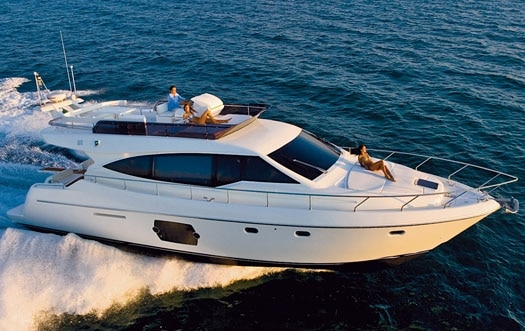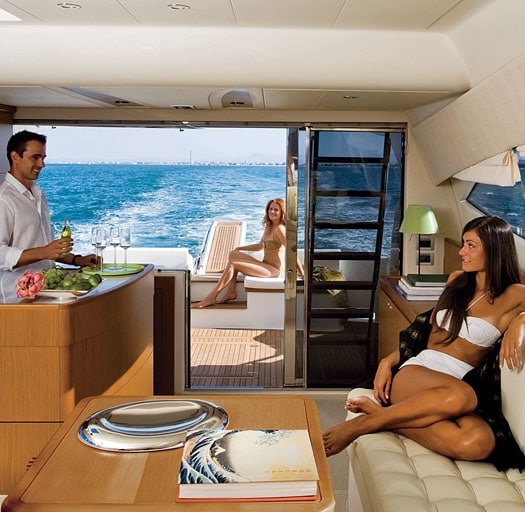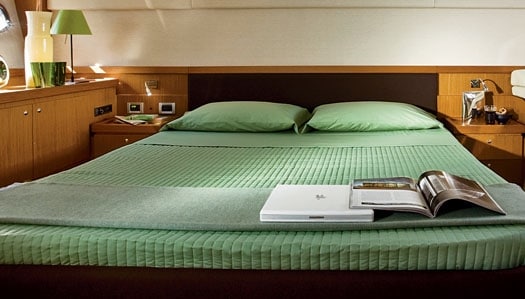
ferretti5101.jpg
It’s official: The motoryacht trend of the year is none other than the galley. And the reason this is so? Ferretti, simultaneously one of the most stylish and most traditional of yacht designers, has given us a new model that enshrines the cooking and entertaining space the way only the most fashion-forward restaurants would dare.
That makes it sound easy, but in fact one of the most difficult jobs for the designer of a motor yacht is the galley. It’s rarely the most attractive part of the yacht and it has to house the large square boxes of the fridge and cooker. The true dilemma, however, is whether to hide it away inconveniently down below or to have it up at deck level where it takes up valuable space. Up till now there has not been a satisfactory solution.
With the new 510 the Ferretti designers have come up with an approach that places the galley at aft end of the saloon on the starboard side. This is prime real estate, and may sound like a recipe for wasted space. But it works brilliantly: The galley has been styled mainly in teak to match the saloon decor and has a bar counter for serving. Located here, it is convenient to the saloon table, but do you see the window at the aft end? Watch closely. It can be hinged upwards to allow the galley to connect with a second serving counter in the cockpit.

| | |
With the galley here your meals can be served equally conveniently whether you feel like dining in the saloon or the cockpit. And, of course, as the galley also doubles up as the bar for both areas, cocktail hour just became a lot easier and more elegant. The execution is up to Ferretti’s high standards: Not only does it work well but it also looks good, and an overhead hatch gives ventilation.
Having seen many yachts this year that have placed the galley more or less at the center of attention, I have no doubt that this will be a muchimitated concept. As trends go, it’s a clever advance in yacht interior design. Best of all, it still leaves a large area of the saloon for the main social area. There are cream leather settees on both sides and a rising TV on the window ledge to starboard.
Forward on the port side by the helm is another innovation. This is a chaise lounge that folds out from the dash and which allows the user to watch the view while lying back in considerable comfort. This is an option, and one that does not seem to offer the most secure position if the boat is moving about at sea. But if you happen to have Cleopatra on board, and conditions are smooth as the Nile, then this will definitely do the trick.
All this innovative thinking about the layout of the galley, deck saloon, and cockpit seems to have been enough for the designers, because down below the layout is classic and conventional, although they do seem to have found a lot of space here for a 51-footer.
The master stateroom is a full width affair with large windows on each side so there is plenty of daylight. Included in this space is another chaise lounge that fits across the port window so here is another chance for your Cleopatra to enjoy the view in comfort. On the opposite side is a desk and a vanity alcove with an equally good view; and at the forward end there is an en suite bathroom.

| | |
The two-berth cabin to starboard has the beds running athwartships with the aft one fitted under the stairway access. There is a surprising amount of deck space here. The forward VIP cabin follows convention with its layout. The furnishings are luxurious in the Ferretti style and the use of teak as the featured wood keeps things looking cleanly traditional. These two cabins share a bathroom on the port side.
At the helm there is a two-person seat, but as seems to be always the case, the wheel is set centrally it would be a squeeze with two people. This is disappointing given that it’s the only forward-facing seat in the yacht (except for those in the cockpit). The dash layout is simple and reasonably logical, though if the dash panel were any higher I might have a quibble as you can just see over it when seated. Still, visibility forward is good with the single large panel windscreen, but a bit restricted at the sides due to the complication of opening side windows.
In the cockpit the passerelle is on the center line with a step up from the aft settee. It also acts as the davit for launching the tender that can be stowed on the wide swim platform. Otherwise the cockpit has been kept simple and clean with the mooring hardware covered when not in use. Rope bins are included. And there is room for a compact crew cabin in the space below the transom.
A teak stairway takes you up to the flybridge. The helm on the port side has all the instruments in a retractable pod and the area is surrounded by a large sun pad. The hatch above the galley opens in the aft end of the sunbed, allowing for a possible internal access stairway. Behind this is a small bar counter, settees and a table .
A problem arises with the very low arch mast extending back from the rear. Someone sitting on the settee could partially block the radar antenna’s beam. (Ferretti is looking at mounting this radar so that it can be raised at sea.) Rails around the flybridge could be higher to offer more security.
The 510 looks low and sleek on the water and there is a hint of aggression in the forward raking flybridge windscreen. Engines on the test boat were the more powerful twin 800-hp MAN diesels (another option is a pair of 730-hp). In both cases the engines drive forward to V-drive gearboxes and then to a conventional shaft and propeller system. An option well worth considering for the 510 is the Anti-Roll Gyro (ARG) that helps to keep the boat stable both at speed and at anchor.
With a hull deadrise of 14.6 degrees the ride was well cushioned in the lively sea conditions of the sea trial. The Mediterranean is rarely calm in the fall, especially when you have a number of fast boats out there showing off, but the 510 coped without complaint. Top speed was a shade over the 30 knot mark, quite adequate for this style of yacht, and it will cruise all day running at an economical 25 knots. The control at slow speed was excellent with the bow thruster keeping things under control. A stern thruster would be another worthwhile option.
In classic Ferretti manner, everything about the 510 speaks of long experience in designing and developing motor yachts. The engineering is up to the usual very high Ferretti standard and the innovative galley layout is brilliant.









